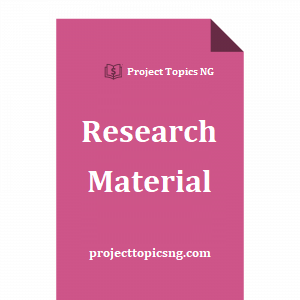Brief Introduction
Nigeria is urbanizing at an astonishing pace. The share of Nigeria’s population increased from 20% in 1970 to about 38% in 1993 (the world banking) of the nearly 110 million Nigerians, about 40 million are now living in cities and towns. The urban population grew at around 5.5% per year from 1980 to 1993 (compared with 2.9% for the national population).
This is among the highest urban growth rates in the world, due mainly to migration from rural areas. At current roles, the number of urban dwellers will double in only 13 years. This is equivalent to a city of three million each year. Such growth is creating an immense and largely unmet demand. For urban services such as water, sanitation, road, public transport, waste disposal, health, and education.
The physical condition of Nigeria’s infrastructure water supply, sewerage, sanitation, urban road, electricity, drainage, waste disposal, school hospital is generally poor. For example, only about half of the people in Nigeria’s urban areas have access to pipe-born water in and, or around their homes.
All types of infrastructure suffer from a massive backlog of neglected rehabilitation and maintenance, not to talk of the investments needed to serve future growth. Periodic and routine maintenance by for the most management of municipal wastes – sewage, seepage, and refuses Nigeria major urban environmental problem.
Table of Content
CHAPTER ONE
Introduction
1.1 Background of the study
1.2 Statement of problem
1.3 Objectives of the study
1.4 Significance of the study
1.5 Significance of the study
1.6 Scope of the study
1.7 Selection of sample cities
1.8 Limitations and delimitations of the study
1.9 Definitions of technical terms
REFERENCES
CHAPTER TWO
2.0 LITERATURE REVIEW
2.1 Financial infrastructure in developing countries earlier approach
2.2 Financing urban infrastructure and services in Nigeria
2.2.1 Immediate priorities
2.2.1.1 Reorientation of public expenditure
2.2.1.2 Targeting the urban poor
2.2.1.3 Counterpart funding from state annual budgets
2.2.1.4 Medium-term agenda
2.2.1.5 Mobilization of state and local revenues
2.2.1.6 Property taxes potential –IDF experience
2.2.1.7 Public sector borrowing
2.2.1.8 Alternative infrastructure financing options
2.2.1.9 Private investment
REFERENCES
CHAPTER THREE
RESEARCH DESIGN AND METHODOLOGY
3.1 General features of the research
3.2 Method of data collection
3.3 Sources of data
3.4 Location of data
3.5 Tools for data analysis
3.6 Basis selection of sample
3.7 Bases of selection
3.8 Location of sample cities
3.9 Overview of sample cities
3.10 Limitations of information
3.11 Method of data analysis
3.12 Data analysis techniques
CHAPTER FOUR
4.1 Data presentation
4.2 Data analysis
4.3 Test of hypothesis
4.4 Inter predating data
CHAPTER FIVE
FINDINGS RECOMMENDATIONS AND CONCLUSION
5.1 Summary of findings
5.2 Conclusion
5.3 Recommendations
BIBLIOGRAPHY


